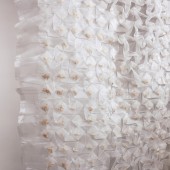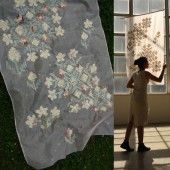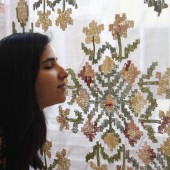
| THE AWARD |
| CATEGORIES |
| REGISTRATION |
| SUBMIT YOUR WORK |
| ENTRY INSTRUCTIONS |
| TERMS & CONDITIONS |
| PUBLICATIONS |
| DATES & FEES |
| METHODOLOGY |
| CONTACT |
| WINNERS |
| PRESS ROOM |
| GET INVOLVED |
| DESIGN PRIZE |
| DESIGN STORE |
| THE AWARD | JURY | CATEGORIES | REGISTRATION | PRESS | WINNERS | PUBLICATIONS | ENTRY INSTRUCTIONS |
Reminiscent Fragrant Textiles by Pallavi Padukone |
Home > Winners > Design #123561 >Interview |
 |
|
FS: What is the main principle, idea and inspiration behind your design?
PP: I use natural ways to integrate fragrances into hand-crafted textiles. The sense of smell is a powerful catalyst to trigger memories and feelings of calm and comfort. My current experimental sensorial collection Reminiscent is dedicated to scents associated with my hometown of Bengaluru, India. I use textiles as aromatherapy to condense time and distance and create an immersive experience to reconnect with nature, nostalgia, home, and identity. Each fragrance represents a different color palette and is translated through handwoven and embroidered wall hangings and tapestries. Collaborating with nature and using only biodegradable materials in my production process, using recycled silk, perfumed pockets, and scent-coated yarn my work explores the concept of fragrances for wellness and how they can be expressed through color, patterns, and textures.
FS: What has been your main focus in designing this work? Especially what did you want to achieve?
PP: My work explores the idea of reinterpreting the fragrance industry by depicting scents through color, texture, and patterns and exploring textiles as a multi-sensorial medium. The pandemic has also made us realize the power of the sense of smell in our lives, whether with the cool, fresh air that we breathe or the myriad of smells that are powerful catalysts that trigger emotional connection and their therapeutic qualities of evoking calm and comfort. At a time when wearing masks is the new normal, and we take our sense of smell for granted, my textiles pay tribute to this powerful sensorial experience and its effect on mental and physical wellness.
FS: What are your future plans for this award winning design?
PP: I would like to further develop the idea of creating sensorial experiences through textiles and fragrances for interiors. I plan to develop collections that are reminiscent of new people, places, and time.
FS: How long did it take you to design this particular concept?
PP: I had started to ideate and experiment with this concept in 2019. The testing and sampling with the coated yarn was during 2020. The research and experimentation are still ongoing and I aim to further develop and refine my ideas and techniques.
FS: Why did you design this particular concept? Was this design commissioned or did you decide to pursuit an inspiration?
PP: This concept was initially born while pursuing my Masters in Textiles. The ideation and exploration were a part of my final capstone project and have been further developed since. The integration of fragrance and textiles resonated with me and I find there is great scope for multi-sensorial textiles in terms of applications.
FS: Is your design being produced or used by another company, or do you plan to sell or lease the production rights or do you intent to produce your work yourself?
PP: As of now, I plan on producing the work myself.
FS: What made you design this particular type of work?
PP: I have an emotional connection with certain fragrances and a passion for textiles. I was intrigued by the combination. In the last year, I feel that connection grew stronger. The sense of smell is such a powerful catalyst to trigger comfort and familiarity. My initial source of inspiration was the calming effect of a small pouch of lavender while being cooped up in my apartment during the lockdown in 2020. This gave me the idea to further explore the concept of scents for wellness.
FS: Who is the target customer for his design?
PP: The textile tapestries can be used in interior settings and spaces for healing and wellness. The scents I have used such as jasmine having calming qualities that work well in such spaces just as hospitality settings, yoga, and meditation centers, and residential spaces. Fragrances can be interchanged depending on the user's mood and the ambiance of the space. The target customer is anyone who has an appreciation for fragrances and textile art.
FS: What sets this design apart from other similar or resembling concepts?
PP: Olfactory art is still up and coming. The techniques used in my textiles are unique and the scent-coated yarn I have developed is one of a kind. An important aspect of my work is the use of natural and biodegradable materials in my production process, including natural dyes.
FS: How did you come up with the name for this design? What does it mean?
PP: The name Reminiscent is a play on words reflecting the connection I have with memories, nostalgia, and scents. My current collection is a library of fragrances that are reminiscent of my hometown of Bengaluru. Fragrance associated with familiar people, places, and times in my life that bring me a sense of comfort.
FS: Which design tools did you use when you were working on this project?
PP: I use the adobe creative suite softwares to develop and plan my patterns and for ideation. My textiles are crafted using the handloom or handset and machine embroidered.
FS: What is the most unique aspect of your design?
PP: Reinterpreting the fragrance industry by using scents as a form of embellishment is a unique concept. My textiles have accessible pockets to store scents that can be replenished or interchanged with new fragrances depending on your mood. My scent-coated yarn can also be integrated into weaving and embroidery. My textiles are all crafted with natural materials.
FS: Who did you collaborate with for this design? Did you work with people with technical / specialized skills?
PP: I have worked independently on this design.
FS: Is your design influenced by data or analytical research in any way? What kind of research did you conduct for making this design?
PP: Fragrance preference is very subjective and personal. I conducted surveys to fuel my research to understand and analyze the connection participants had linking smells to memories, emotions, textures, colors, and visual cues.
FS: What are some of the challenges you faced during the design/realization of your concept?
PP: I initially saw the temporality of scents as a challenge, but I grew to accept the beauty of impermanence. The scents on these textile pieces in my collection continue to remain anywhere up to three months, depending on their exposure to heat and light. The impermanence is a reminder of its completely natural state as they absorb new smells, just as dyes tend to alter with time.
FS: How did you decide to submit your design to an international design competition?
PP: My intention to submit my work to an international design competition is to put my work and ideas out there in the world, to get feedback, and connect and collaborate with others in the industry.
FS: What did you learn or how did you improve yourself during the designing of this work?
PP: This project was research and material explorative and involved several rounds of testing for the coating and with textile production techniques. I further expanded my research with natural dyes as well. Overall, the project was a learning process.
FS: Any other things you would like to cover that have not been covered in these questions?
PP: The power of fragrant textiles has great scope for applications. I am keen to further develop this project and open to collaborations and commissions.
FS: Thank you for providing us with this opportunity to interview you.
A' Design Award and Competitions grants rights to press members and bloggers to use parts of this interview. This interview is provided as it is; DesignPRWire and A' Design Award and Competitions cannot be held responsible for the answers given by participating designers.
| SOCIAL |
| + Add to Likes / Favorites | Send to My Email | Comment | View Press-Release | Translations |





